Thermaltake Tenor
And finally, the Tenor from Thermaltake. With a slightly different approach to the layout of components, which we’ll get to later, the Tenor manages to hold more externally available drives than any other HTPC in this roundup without being substantially taller.
Taking a different spin on aesthetics, the Tenor has a very curvaceous front and a two-tone paint job. The top is finished in a glossy metallic silver while the front is brushed, anodized aluminum.
Our model came in silver, but a black version is available also.
To keep the front as simple as possible, the port cluster has been moved to the side and features the usual combination in the cramped configuration that will frustrate users with larger USB devices or audio cables.
Also on the left side, but along the front edge, is the power and reset buttons, along with the HDD and power LEDs. We particularly like how Thermaltake has done the indented line through the buttons and embossed logo in the upper left-hand corner. The finish of the Tenor is definitely as good as or better than all the other case’s in the roundup, as is also evident in this shot of the Thermaltake logo on the lower right side.
Another different idea implemented in the Tenor is a method for stealthily concealing all the drives, which has been pulled off rather effectively via a simple push-latch hinge, and resistance gearing to slow the fall of the cover.
Separating the case into segments are three mirror-finished pieces, which really add to the elegance of the design in our opinion. In this close-up, you can also see the gears that slow the fall of the main door, along with the push-latch that makes the next feature (that we’ll be looking at) work.
Instead of always having to open the entire door to simply get at an optical drive, the Tenor also gives one the option to get at just the bottom 5¼” drive via a second push-button door.
And finally, the Tenor from Thermaltake. With a slightly different approach to the layout of components, which we’ll get to later, the Tenor manages to hold more externally available drives than any other HTPC in this roundup without being substantially taller.
Taking a different spin on aesthetics, the Tenor has a very curvaceous front and a two-tone paint job. The top is finished in a glossy metallic silver while the front is brushed, anodized aluminum.
Our model came in silver, but a black version is available also.
To keep the front as simple as possible, the port cluster has been moved to the side and features the usual combination in the cramped configuration that will frustrate users with larger USB devices or audio cables.
Also on the left side, but along the front edge, is the power and reset buttons, along with the HDD and power LEDs. We particularly like how Thermaltake has done the indented line through the buttons and embossed logo in the upper left-hand corner. The finish of the Tenor is definitely as good as or better than all the other case’s in the roundup, as is also evident in this shot of the Thermaltake logo on the lower right side.
Another different idea implemented in the Tenor is a method for stealthily concealing all the drives, which has been pulled off rather effectively via a simple push-latch hinge, and resistance gearing to slow the fall of the cover.
Separating the case into segments are three mirror-finished pieces, which really add to the elegance of the design in our opinion. In this close-up, you can also see the gears that slow the fall of the main door, along with the push-latch that makes the next feature (that we’ll be looking at) work.
Instead of always having to open the entire door to simply get at an optical drive, the Tenor also gives one the option to get at just the bottom 5¼” drive via a second push-button door.


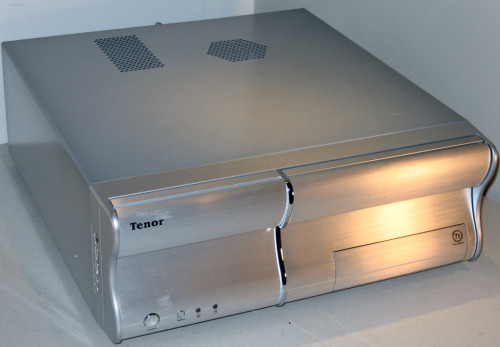

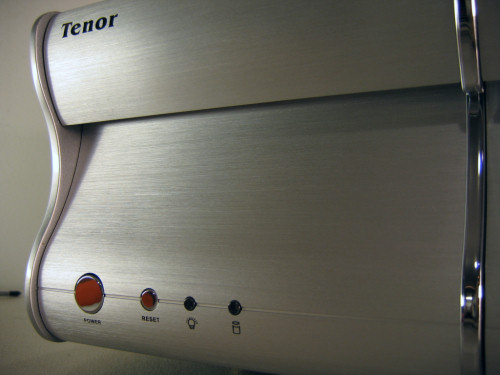
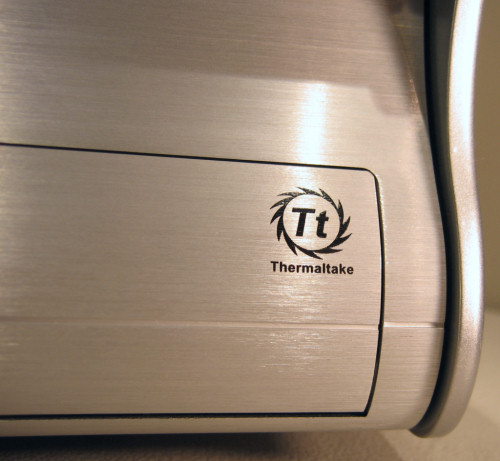
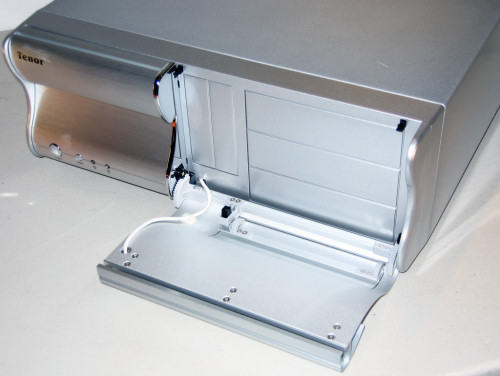
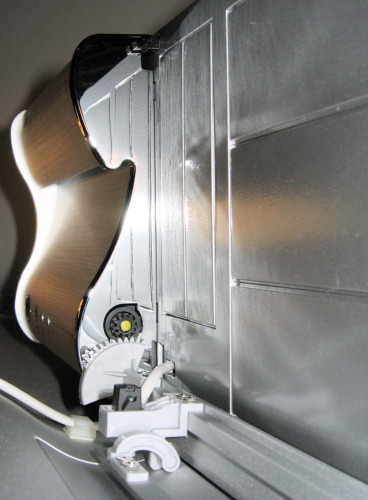









26 Comments
View All Comments
Tamale - Tuesday, November 22, 2005 - link
The 'POS' power supply happens to deliver steadier voltages to the highest-end gear I've gotten my hands on (and no, the P4 test bed isn't the most powerful thing I've tested it in) than anything else that's passed through my hands, and that includes over a dozen power supplies by high-end manufacturers. I'm no reviewer of power supplies yet, as we're still working on that, but I guarantee you that this is a fine unit, especially for the area of case reviews, because in quiet mode it does a fantastic job of staying silent enough to hear the case fans and still provides rock-solid voltages to a stressed-out system. It also gets warm when in quiet mode in the cases that don't ventilate the power supply well enough, which is another good measure of a case. Perhaps most important however is the modular nature of the unit, and even though I've tried other modular units none were as quiet as the MadDog.Secondly, the thermaltake golden orb II at full voltage is quieter than any of zalman's coolers at full voltage. While I understand that the zalman will probably get lower temperatures, It is absolutely essential that the CPU cooler in my test bed make as little noise as possible, and the golden orb II does just that.
The recurring theme in your post seems to me to be that you want 'the perfect HTPC', but the whole idea of a case review is to isolate everything but the case as much as possible, and sometimes hotter components do a better job of illustrating the deficiencies of units than the latest and greatest.
Trust me on this one, if we used the absolute best gear available the comparisons would be much muddier.
As for the subjective comment, my scale of 1-10 can be thought of as a scale of tolerance.. with 5 basically being the threshold... anything higher than that really is 'too loud for the given application' and anything lower than 4 is 'acceptable'. It's not meant to be a numerically accurate scale of any sort. I felt very comfortable with the final subject ratings I gave these cases, because the Tenor and PC-800B just barely passed my personal threshold test, and I believe most users will agree.
tayhimself - Tuesday, November 22, 2005 - link
I hope you realize other PSUs are likely quieter and more efficient than "Mad Dog". Sure the may be quiet to your ears, but thats too subjective to really mean anything. Sadly, you rate the modular nature as being an important issue when it is not. The PSU getting warm in quiet mode may be a sign of a PSU not getting enough airflow.And you say "its silent enough to hear case fans". While that can be true, the PSU and Tt golden orb noise signatures can drown out subtler differences between the cases in terms of noise of the case fans. This is almost obvious from your review as you dont perceive the difference of 9 dB to be significant. Its better to use quality quiet components so you can tell what the case is contributing to the noise spectrum. Since this is about making case buying decisions, the other factors are best isolated.
Avalon - Tuesday, November 22, 2005 - link
Get crackin'.mrgq912 - Tuesday, November 22, 2005 - link
to tired to read the article but first post.mrgq912 - Tuesday, November 22, 2005 - link
okay now that I have that out of my system. How come you guys never review stuff from alienware or voodoopc. Those guys make HTPC's aswell. I never every heard of the players in this review making HTPC's untill today. Well nice to know i have options.Would buy one if i could, untill then i will live with my ati tv wonder elite.
ksherman - Tuesday, November 22, 2005 - link
uh, cuz Alienware and Voodoo are over priced peices of DooDoo... and because this site is more geared around people that build their own machines...